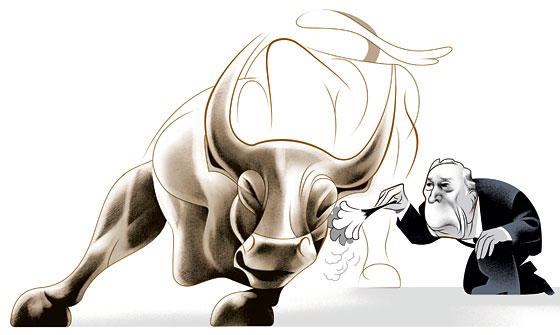
Bloomberg’s One Percent Solution
Chris Smith
For the mayor, grappling with Occupy Wall Street is confoundingly personal.
On September 16, Mayor Bloomberg did his weekly radio show with John Gambling. The Friday-morning chats are usually fairly sedate. But this time, when Gambling asked Bloomberg about a historic rise in the national poverty rate, the mayor made headlines. “You have a lot of kids graduating college who can’t find jobs,” he said. “That’s what happened in Cairo. That’s what happened in Madrid. You don’t want those kinds of riots here.”
The remarks seemed a little off on the facts—leaving out decades of political repression in Egypt, for instance—and were mostly ridiculed as alarmist. Even a mayoral aide tried to turn down the volume by explaining that Bloomberg’s choice of words was a “euphemism.” The next day, though, Occupy Wall Street moved into Zuccotti Park. Soon the mayor’s comments looked as if they’d been informed by an advance warning, maybe good intelligence from the NYPD.
Which would make for a nice, tidy narrative. The reality is that the timing was merely a coincidence. Even if Bloomberg was proved prescient about the darkening mood, he was just as surprised by the encampment’s arrival as everyone else. In the two months since, there have been miscalculations, accidents, and revelations (who knew from the quirky rules of a public private space?) as the movement spread nationally, even internationally, and was stirred last week by the predawn raid ordered by the mayor that recaptured Zuccotti Park.

Illustration by André Carrilho
Bloomberg’s response to Occupy Wall Street would have been a major part of his legacy even if the mayor had previously been a lifelong political hack. But because Bloomberg is Wall Street, the stakes and symbolism were exponentially heightened, and these eight weeks will take on outsize significance in how his twelve years in office are judged. Bloomberg ran on the premise that his money put him above politics. And in many ways, he’s been in sync with the city’s broad consensus on social issues—the importance of public education, the sanctity of immigration, the hatred of gun violence, the tolerance of religious and sexual differences. Yet when it comes to anything having to do with money or business, Bloomberg is an ineluctable member of the ruling class, and it’s part of the reason New York elected him. He’s the result of the hard bargain we made in the traumatic aftermath of 9/11, when our tallest symbols of capitalism had been destroyed: We put a moneyman in charge, hoping that he’d manage basic services with business-honed competence and attract new jobs for the city’s reeling economy. That gamble largely paid off, though Bloomberg’s vision of New York as a luxury good and his shameless buying of a third term turned out to be unpleasant side effects.
Ten years later, as we move from the terror era to the income-inequality era, it is an absolutely fitting twist of fate that New York, home of Wall Street and birthplace of Occupy Wall Street, is ruled by a $20 billion man. What’s been fascinating about his response to the movement, though, is that Bloomberg has been displayed in full three dimensions: a man who absolves his fat-cat cohorts of blame for the financial crisis but tries to clean up the damage they’ve done; a man not completely able to transcend his one percentness to be a mayor of all the people but no heartless autocrat, either. Rudy Giuliani, the prosecutor-mayor, would have sent the cops into Zuccotti Park immediately, and swinging. For two months Bloomberg, the mogul-mayor, struggled to find a balance between his high-minded defense of First Amendment rights in the abstract and their messy physical expression in Zuccotti Park. Mistakes by his police department gave the movement new life: The YouTubed pepper-spraying of a female protester, the mass arrest of marchers on the Brooklyn Bridge. Still, Bloomberg resisted the complaints of his friends in the real-estate industry, hoping the protest would fade on its own. That didn’t happen. Then a mid-October plan to remove the Occupiers for a cleaning of the park was suddenly canceled.
If Bloomberg looked indecisive and conflicted, perhaps that’s because he was. Getting in the way of deeper sympathy for the movement was the fact that he rejects most of its premises. Since Occupy Wall Street appeared downtown, the mayor engaged only briefly with its central point, that the economic game is more rigged in favor of the powerful few than ever before. His perspective was plenty clear anyway. In August 2007, Bloomberg blamed home buyers “who really didn’t have the wherewithal” or “lied about their incomes” for taking out loans that later exploded. This November, during a panel discussion with former mayors Ed Koch and David Dinkins, Bloomberg claimed it was big bad Congress that forced the poor innocent banks to make all those booby-trapped loans, and blamed Freddie Mac and Fannie Mae for fueling the bubble. Never mind that everyone from the nonpartisan Government Accountability Office to the St. Louis Federal Reserve has debunked that simplistic reasoning with actual evidence. So that’s what he believes And yet what’s confusing about this mayor is that his actual policies to address the local fallout from the recession are often significantly more enlightened than his rhetoric. In 2008, for instance, he backed an effort by his then–housing commissioner, Shaun Donovan, and the City Council to establish the Center for NYC Neighborhoods. It has helped more than 14,000 city homeowners fight foreclosure.
